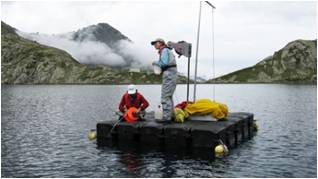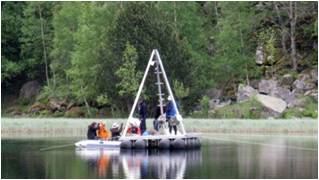We monitor a number of biogeochemical and biodiversity variables in atmospheric deposition, lakes, and streams in several experimental catchments of the Central Pyrenees. Our aim is to reveal environmental changes that, because of the remoteness of our study sites, are a reflection of global change. Multi-decadal data series allow us to detect early indications of change and to establish the causal links. This long-term ecological research (LTER) is necessary because large-scale environmental changes occur at a slow pace, may be subtle and difficult to sense, and sometimes a time lag exists between the causing action and the response. Typically, it may take several decades realizing the environmental change, partially understanding its consequences and taking effective actions for mitigation. This has been the case for acid deposition, long-range persistent organic pollution, CO2-induced climate warming, and forcing of the biogeochemical cycle of reactive N. Natural waters carry chemical and biological fingerprints of the many ecological processes in which water is involved, which we use for unveiling the on-going changes.
Sediments cores retrieved from different lakes have allowed us to reconstruct climate and human influence on remote mountain lakes and surrounding ecosystems during the last 15,000 years. Lake sediments archive environmental and ecological information far beyond the lake limits. In the current context of global change, mountain lake sediments contain an invaluable information on postindustrial changes that can be benchmarked against early, pre-disturbance, intervals. The palaeolimnological reconstructions allow us to extend our contemporary observations back in time and offers a reference to assess the importance of present-day changes. Furthermore, sediment archives provide a long-term view of the ecological dynamics that cannot be captured by observational series. As nature never goes the same way twice, the long-term change is more than the sum of the short-term fluctuations. A number of cores retrieved from different lakes have allowed us to reconstruct the winter climate during the Holocene and a lead pollution dated a few millennia back.
The Pyrenees hold a lake district with a few more than one thousand mountain lakes (> 0.5 ha), about a half of them in each the northern and southern slopes. The lithology varies along the range, and the lakes lie on bedrocks as diverse as granites, slates, schists, limestones, and volcanic materials. The Pyrenees are located in a climatic transition area: the western lakes are more influenced by the Atlantic climate regime, whereas the eastern lakes receive higher Mediterranean influence. And, of course, the lakes are distributed along an altitudinal gradient, spanning from 1600 to nearly 3000 m a.s.l. All these features have an effect on the physics, chemistry and biology of the lakes. Several surveys, carried since 1987 at decadal intervals, have provided a synoptic view of the lake ecosystems of the Pyrenees and revealed the recent temporal trends caused by the diverse environmental drivers at a regional scale.








